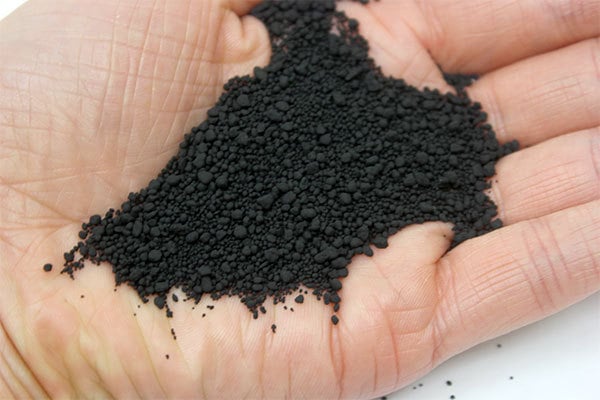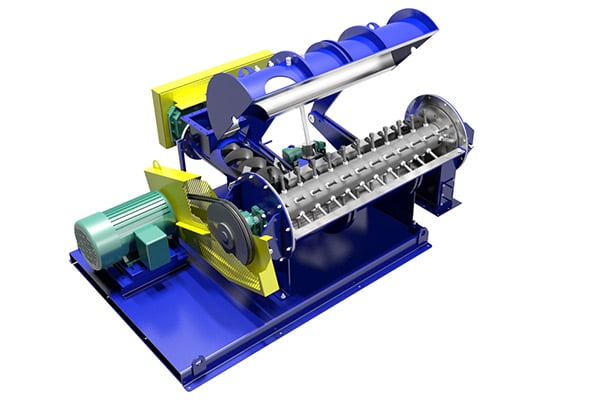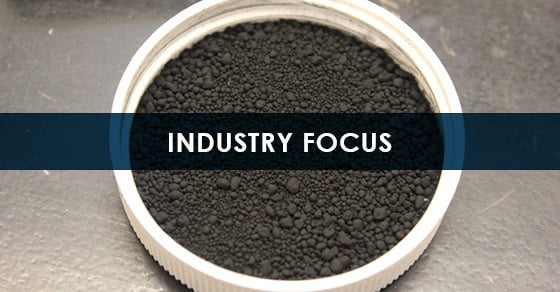Carbon-based materials are an essential component in our everyday lives, from the fuel heating our homes, to the tires on our cars, and even in plastics; carbon as an industrial material is all around us.
Carbon materials exist and are produced in a wide array of forms and derivatives. They are incredibly diverse, both in form and function, but have one thing in common: they are typically dusty and difficult to handle. Thus, pelletizing – a form of agitation agglomeration also known as wet granulation – has become a critical tool in managing the dusty nature of such carbon products, and one device has the market cornered: the pin mixer.
Carbon Dust Suppression
Fine carbon materials present a number of challenges that make dust suppression a top priority. Dust from carbon materials must be carefully managed, as depending on the unique type and form, it may be associated with health and safety hazards, or even a combustion risk. At the same time, a dusty product can present processing challenges and result in product loss. For these reasons, the best approach to dust suppression is not suppression at all; it’s prevention, and that’s precisely why the pin mixer was developed: for de-dusting and pelletizing carbon black in the early half of the 20th century.

Carbon black de-dusted in a FEECO Pin Mixer
Why the Pin Mixer?
The pin mixer is a continuous, industrial mixer used in the processing of bulk solids. Having been originally developed specifically for the unique challenges of the carbon black industry, the pin mixer offers unmatched capabilities when working with ultra-fine powders. It has since moved well beyond the carbon black industry as the device of choice when combining ultra-fine powders with liquid binders for a homogeneous mix.

3D Model of a FEECO Pin Mixer used in carbon material dust suppression
How the Pin Mixer Operates
Comprised of a rotating shaft affixed with rods (pins) inside a stationary trough, the pin mixer utilizes rotational, medium-shear action to thoroughly mix liquid and solid feed components and condition material into seed pellets.
This process may be referred to by a variety of names, including:
- Dust wetting
- Micro pelletizing
- Pelletizing
- De-dusting
- Conditioning
Benefits to Pelletizing Carbon Materials
Although the primary intention with pelletizing materials such as pet coke, coal, biochar, graphene, carbon black, and the like is dust suppression, pelletizing in a pin mixer also offers a few other significant advantages to carbon products:
Improved flow properties
While many factors play into a given material’s flowability, one key aspect is particle size. Materials exhibiting a fine particle size are inherently less flowable. By increasing the particle size (and because pellets produced in a pin mixer are more rounded), flowability is greatly improved.
Improved transportation economics
Pelletizing in a pin mixer is also a way of increasing product density, which ultimately improves transportation economics by allowing more material to be shipped in the same size container.
Particle engineering
Processing in a pin mixer offers the opportunity to control various particle characteristics. This ability is especially valuable when it comes to carbon materials, because of their diverse and highly specific uses. Particle characteristics that can be controlled include:
- Particle size distribution
- Crush strength
- Compression strength
- Attrition/Degradation
- Shape
- Density
- Formulation
- Moisture content
Pin Mixers in a Larger Carbon Pelletizing Process
While the pin mixer is widely used on its own as an agglomeration and mixing device, it may also be used in combination with other agglomeration equipment in a pelletizer plant. Depending on the intended use of the material and subsequent processing requirements, a more substantial agglomeration process may be chosen over a pin mixer in order to produce larger, more refined carbon-based pellets.
In this setting, the pin mixer remains an important process component. When employing a disc pelletizer or agglomerator, the pin mixer serves the essential role of preconditioning material for optimal pellet growth in the subsequent agglomeration device. The pin mixer still performs the same process, but the product discharged now serves as a feedstock from which to produce larger pellets.
The seed pellets formed in the pin mixer are fed to either a disc pelletizer or rotary drum agglomerator, where additional binder, fines, and agitation grow the pellets in a layering effect known as coalescence.
In this case, the pin mixer provides not only the seed pellets, but also uniformity in the product; the binder and fines are processed into a homogeneous mixture prior to entering the secondary agglomeration device.
The Pin Mixer for Dust Suppression: Is It Right for Your Carbon Material?
While the pin mixer is the preferred device in most carbon processing scenarios, it may not be a fit for all materials. This typically depends on the characteristics of the unique material and the specific processing goals. Whether or not a pin mixer is the right fit for a given material is determined through testing such as that offered in the FEECO Innovation Center, where batch pin mixers are available for evaluating the material, as well as for gathering the process data used in the scale-up process.
Conclusion
Despite the multitude of carbon materials and the diverse ways in which they are processed, the pin mixer continues to play an important role in processing carbon materials, offering unmatched dust suppression and pelletizing capabilities.
FEECO is the leading provider of custom pin mixers for processing carbon materials. All FEECO pin mixers are designed around the characteristics of the unique carbon material to be processed and backed by our state-of-the-art Innovation Center and parts and service support. For more information on our pin mixers, contact us today!



